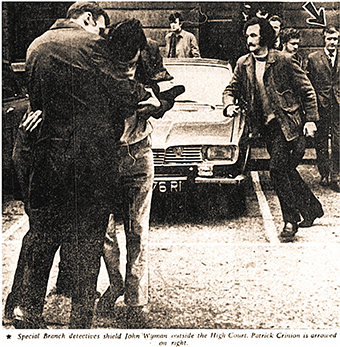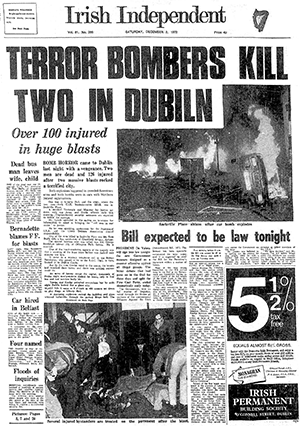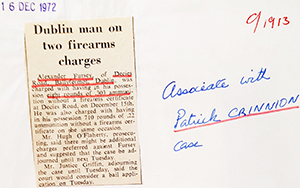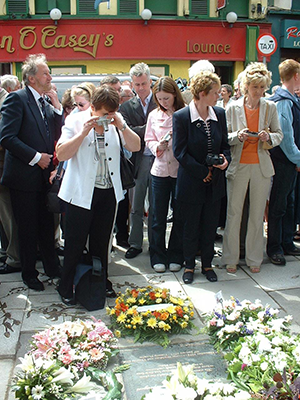The 1972–3 Dublin bombings
Published in 20th-century / Contemporary History, Features, Issue 3 (May/June 2018), Volume 26The ‘third man’ in the case of British agent John Wyman and Garda Sergeant Patrick Crinnion.
By Margaret Urwin and Niall Meehan
On 1 December 1972 at 7.58 and 8.15pm, as the Irish Times reported, ‘Two [car] bombs in Dublin city centre killed two [CIÉ workers], injured 127 other people, and dramatically changed the course of the Dáil crisis over the Offences against the State (Amendment) Bill’. The legislation permitted a court to accept as proof of IRA membership the uncontested word of a Garda chief superintendent.
The bombs were the second in a series of three in Dublin between November and January. They prevented a general election by collapsing Fine Gael opposition to the controversial measure. British involvement was suspected by then taoiseach Jack Lynch. Nevertheless, his government ensured that an MI6 agent, John Wyman, and Patrick Crinnion, Wyman’s mole in Garda HQ, arrested nearly three weeks later, were freed prematurely.
A ‘third man’, whose role was hidden, led the Gardaí to Wyman. The Gardaí told the taoiseach about him. The Department of Justice, under then minister Desmond O’Malley, must also have known. Judge Henry Barron’s 2004 report on the 1972–3 bombings, which considered the Wyman–Crinnion scandal, ignored his existence. The Irish Press initially reported the arrest of two British agents, in addition to a Garda member ‘employed in a clerical capacity at Garda headquarters’ (Crinnion’s position). After that, this second British agent was forgotten.
Alexander Forsey

Above: This photograph, reportedly of Patrick Crinnion (arrowed), by Irish Times photographer Paddy Whelan, appeared in the Irish Independent on 4 March 1973. It had previously appeared, but without identifying Crinnion, in the Irish Times of 22 December 1972. The Irish Independent Irish Newspaper Archive version is damaged. Unusually, the top of the photo, including faces, is sliced off. (This copy was obtained in the British Library.) Irish Times Photo Sales is not in a position to release Paddy Whelan’s original photographs of Crinnion or of Wyman, whose face also appeared in the newspaper on 22 December 1972.
A March 1973 Irish Press article on the Wyman–Crinnion affair indicated how Forsey had come to official attention. In December 1972, Gardaí questioned suspects about an unsuccessful 26 November attempt to free recently convicted IRA chief-of-staff Seán Mac Stiofáin, who was in Dublin’s Mater Hospital, suffering from the effects of a hunger and thirst strike. According to the Press, using anonymous sources, during interrogation one of the suspects named an additional ‘IRA man’. This was Forsey, presumably, and Gardaí raided his home, where they discovered illegally held material.
In Dublin in April 1972 Forsey had obtained an advertised post as manager of a grocery/hardware store in Decies Road, Ballyfermot. He claimed that he had been living in Derry and was married to a Derry woman, and reported having two children. In 2008 Margaret Urwin interviewed the shop’s owner (now deceased). He occasionally visited the Forseys, who lived over the premises, but could not recall seeing any children.
Forsey said that he was a member, possibly treasurer, of a local Sinn Féin cumann, in either Ballyfermot or Inchicore. He displayed photographs of dead IRA Volunteers on the walls of his flat. The owner, an Irish Air Corps captain, felt that Forsey ‘might not be all he claimed to be’. He spotted a Morse code transmitter, which Forsey explained away by claiming to be an amateur radio ham.
Agents of Wyman

Above: Front page of the Irish Independent on Saturday 2 December 1972.
One week after a 12 October 1972 bank robbery, the largest in the state’s history, the Littlejohns were arrested in London on foot of an extradition warrant. Prior to a court appearance on 24 December, the brothers called British government officials as witnesses in order to corroborate their status as intelligence assets. Extradition proceedings were thereafter held in camera. The Littlejohn–Wyman connection was yet to emerge.
On 17 December Special Branch detectives tailed Wyman’s taxi to the West County Hotel, Chapelizod. The following day they arrested him and discovered that he had an additional room booked at Dublin’s Burlington Hotel. Over 18–19 December two Special Branch detectives waited within, where they found a note from someone promising to return. At 9.15pm on 19 December someone knocked and asked for ‘John’. ‘John who?’, asked one of the Gardaí. ‘John Wyman’, said Patrick Crinnion. After identifying himself, Crinnion agreed to accompany detectives for questioning. He then attempted to escape and was arrested. Crinnion was private secretary to Special Branch head John P. Fleming. His task was to collate Special Branch reports on subversive activity, in particular near the border, for the Garda C3 security section. A search of Crinnion’s car revealed, under a carpet behind the passenger seat, ten secret documents or groups of documents. In Crinnion’s home Gardaí discovered more officially secret information.
‘Public relations’ problem for the Irish government

Above: ‘Associate with Patrick Crinnion case’—Forsey’s connection to the Wyman–Crinnion saga is revealed officially in a handwritten instruction within a Military Archives file in Cathal Brugha Barracks.
On 3 January 1973 the Irish government’s problem was compounded when the British admitted privately that the Littlejohns were also their agents. These events had the potential to be acutely embarrassing to the then Fianna Fáil government. It appeared that legislation was assisted onto the statute book by the very thing it was designed to defeat—subversive violence, albeit of a state-sponsored variety. Public confirmation might have transformed a public relations problem into a crisis.
Wyman in Dublin on 1 December
During his February 1973 trial under the Official Secrets Act, Wyman’s notebook was produced. Entries mentioned in court included ‘RLs’, ‘car bombs’ and ‘arrest policy’. Wyman explained that ‘RLs’ were rocket launchers, which he said the IRA were using. ‘Car bombs’ referred to the Dublin explosions. Of those he said, ‘We are as interested in finding out who did this as you are’. Wyman did not elaborate on his ‘arrest policy’.
Wyman’s research was not merely passive. Republican John Kelly recalled in 2003 having seen Wyman assessing crowd reaction after the 1 December 1972 bombings. A 22 December Irish Times photograph made Wyman identifiable. From his demeanour Kelly thought initially that Wyman was Special Branch, but noted that they did not acknowledge him. Kelly was arrested soon afterwards on an IRA charge. On 6 February he appeared in the Special Criminal Court, the day Wyman also appeared.
Evidence withheld
On 27 February 1973, Crinnion and Wyman were convicted on summary charges and sentenced to three months’ imprisonment. More serious charges fell when Desmond O’Malley ordered the withholding of evidence on which the charges were based. His explanation (in 2005) that he did not wish to reveal Garda sources was puzzling. After all, court proceedings were held in camera. In any case, the British would have deduced that Forsey, in court on 15 December, had betrayed Wyman.
Wyman and Crinnion, having served two months on remand, were released and vanished. Separately, Alexander Forsey was convicted on 7 February and received a three-year suspended sentence. His counsel, Patrick MacEntee, referred obscurely to ‘a strange and special case with no possibility of a recurrence’. Forsey’s Wyman connection was not revealed. Like Wyman, he fled to England. Forsey’s wife informed the shop’s owner that his life was in danger. She left shortly afterwards.
One day after Crinnion and Wyman departed, the Littlejohns arrived in handcuffs. Kenneth Littlejohn did not appreciate his sacrificial, choreographed, ‘small-fry’ part in the unfolding drama. He revealed that Wyman, known to him as ‘Douglas Smythe’, was his handler, and that his violence was designed to bring about the legislation whose passage the Dublin bombings guaranteed. As Dick Walsh and Denis Coghlan observed in the Irish Times, the extension of the Northern conflict to the South had to be presented as an authentic ‘republican’ threat in order to justify O’Malley’s anti-IRA legislation.
‘Mr Lynch’s mind’

Above: Family and friends at the unveiling on 22 July 2004, organised by Justice for the Forgotten, of a permanent memorial to the three CIÉ workers killed in the bombings—George Bradshaw and Tommy Duffy in December 1972 and Thomas Douglas in January 1973. All three died in Sackville Place, just off O’Connell Street. (An Phoblacht)
The following August (1973), after the Littlejohns received sentences of fifteen and twenty years, Jack Lynch, now leader of the opposition, claimed that his government was unaware of the Littlejohn British intelligence link. He was forced to retract immediately. He said that he ‘forgot’. Lynch also stated that, though he was ‘suspicious’ of British involvement in the 1972 Dublin bombings, he had no evidence. That is because, owing to a combination of action and inaction, his government opened the door to the premature release of Patrick Crinnion, John Wyman and Alexander Forsey. If left to cool their heels in an Irish prison, more evidence of British complicity might have emerged. Failure by the Barron Inquiry to consider Alexander Forsey’s existence and activities was a serious omission, as was the failure to consider Éamonn Ó Fíacháin’s affidavit.
Margaret Urwin manages Justice for the Forgotten (affiliated to the Pat Finucane Centre) and is the author of A state in denial (2016); Niall Meehan is head of the Journalism and Media Faculty in Griffith College and is the author of The embers of revisionism (2017).
Read More:
Barron Report on 1972–3 bombings: error and omission
















